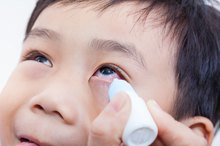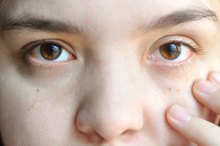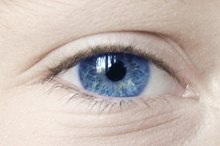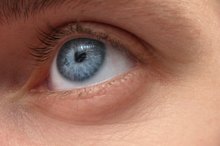Signs & Symptoms of a Cold Sore in Your Eye
Cold sores are the result of the herpes simplex virus 1. An outbreak most commonly causes blisters like cold sores around the nose and mouth, but occasionally the blisters will affect the eye as well. A cold sore in your eye needs to be treated immediately as it can result in scarring that can damage eyesight, so it is important to recognize the symptoms quickly.
If you are experiencing serious medical symptoms, seek emergency treatment immediately.
Tearing
One common sign of a herpes virus cold sore in the eye is excessive tearing 1. The herpes virus is a viral infection, causing the body to excrete higher levels of mucous 1. Our eyes naturally tear to remove foreign substances from the ocular region, so chronic tearing will result from a herpes virus cold sore to remove the excess mucous 1.
Redness and Inflammation
What Causes Eye Mucus?
Learn More
The herpes virus blisters that form in the eye to create the cold sore can cause redness and inflammation 1. The sclera part of the eye, which is the white section, will generally become light pink to dark red depending on the level of irritation. The sclera, eyelids and eye rim may also become red and appear to be inflamed and swollen.
Blurred Vision
The inflammation and excess mucous present in the eye can often result in blurred vision. Inflammation can also be a factor in distorting vision ability, so if you are prone to herpes virus cold sore outbreaks, blurred vision and eye irritation may be a sign that an outbreak is occurring 1.
Pain and Discomfort
Causes of White Eye Discharge
Learn More
All of the symptoms of a cold sore in your eye can cause overall pain and discomfort. Your eye is likely to be tender and painful to the touch, and you may even experience pain with regular blinking. Pain and discomfort in the eye should never be ignored, whether it is from a herpes virus cold sore or not, so seek medical attention at the first sign of consistent pain 1.
Related Articles
References
- American Medical Association Family Medical Guide, 4th Edition; American Medical Association; 2004
- Ramchandani M, Kong M, Tronstein E, et al. Herpes Simplex Virus Type 1 Shedding in Tears and Nasal and Oral Mucosa of Healthy Adults. Sex Transm Dis. 2016;43(12):756-760. doi:10.1097/OLQ.0000000000000522
- Institute for Quality and Efficiency in Health Care (IQWiG). Cold sores: Overview. 2018.
- Montgomery-cranny JA, Wallace A, Rogers HJ, Hughes SC, Hegarty AM, Zaitoun H. Management of recurrent aphthous stomatitis in children. Dent Update. 2015;42(6):564-6, 569-72. doi:10.12968/denu.2015.42.6.564
- Krissel JD, Bhatia A, and Thomas A. Cold sore susceptibility gene-1 genotypes affect the expression of herpes labialis in unrelated human subjects. Hum Genome Var. 2014; 1: 14024. doi:10.1038/hgv.2014.24
- Fatahzadeh M and Schwartz RA. Human herpes simplex virus infections: Epidemiology, pathogenesis, symptomatology, diagnosis, and management. J Am Acad Dermatol. 2007;57(5):737-63. doi:10.1016/j.jaad.2007.06.027
- Formica M, Kabbara K, Clark R, Mcalindon T. Can clinical trials requiring frequent participant contact be conducted over the Internet? Results from an online randomized controlled trial evaluating a topical ointment for herpes labialis. J Med Internet Res. 2004;6(1):e6.
- American Academy of Dermatologists. Cold sores: Overview.
- American Academy of Dermatologists. Cold sores: Signs and symptoms.
- American Academy of Dermatologists. Cold sores: Tips for managing.









